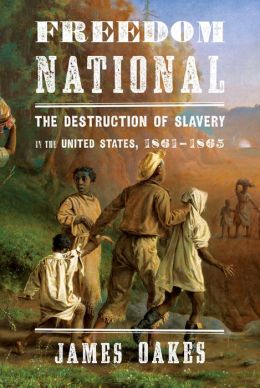
From the Washington Post Book Review of, "‘Freedom National: The Destruction of Slavery in the United States, 1861-1865’ by James Oakes," by Howell Raines, on 18 January 2013 -- The Republican newspaper publisher Horace Greeley bowed to no man north of Richmond when it came to underestimating Abraham Lincoln. In the late summer of 1862, his New York Tribune was pummeling the president for dragging his feet on an expected blanket announcement freeing all slaves in the rebel states. In response to these stinging editorials, on Aug. 22 of that year Lincoln penned one of the most puzzling letters of his presidency. He reminded Greeley that the great mission of the war was restoration of the Union. He continued, “If I could save the Union without freeing any slave I would do it, and if I could save it by freeing all the slaves I would do it; and if I could save it by freeing some and leaving others I would also do that.”
Was Lincoln really a “Reluctant Emancipator,” as Greeley and many historians since his day have insisted? Then why did the 16th president, only a month later, on Sept. 22, convene his Cabinet for a surprise reading of the Emancipation Proclamation and release it upon the public “like a thunderbolt” that same day?

In “Freedom National,” historian James Oakes answers that question eloquently and, in the judgment of this amateur student of the Civil War, fully. Oakes argues that Lincoln, from the moment of his inauguration, began using every political and military means at his disposal to wipe out slavery forever. Yet he also believed, as did virtually all politicians on both sides, that the Constitution protected slavery as a right of individual Southern states and therefore allowed him to designate only one casus belli— the preservation of the federal nation.
“Unless the Constitution was rewritten, the federal government could not constitutionally wage a war for the purpose of destroying slavery,” Oakes explains. “Only the ‘military necessity’ of suppressing the rebellion could legally justify emancipation. That, at least, was the standard Republican Party position all through the war, and Lincoln’s answer to Greeley merely restated it.”

Yes, one must agree, but what a restatement! His letter embodied the kind of virtuous obfuscation that only Lincoln, the presidency’s greatest natural political genius, could have managed. Or make that stage-managed. The theatrical analogy seems proper for a moment when the movie “Lincoln” is vividly re-creating the final act of the emancipation drama. As the film demonstrates, so attuned was Lincoln to the social, legislative and constitutional uncertainties of the coming Reconstruction that he foresaw that he could fully liberate 4 million new black citizens only by pushing for a new amendment to the Constitution (the 13th). This valuable book, along with Doris Kearns Goodwin’s “Team of Rivals,” gives inquisitive moviegoers access to the full backstory.
Oakes’s detailed account of this complex story cannot be fully summarized here. But his argument that emancipation was a process, not the result of a single document, produces some helpful distinctions and benchmarks. Lincoln understood from the moment his armies went South that “military emancipation” would permanently free blacks in conquered territory. Early in the war, slaves who fled into Union lines were deemed to be beneficiaries of “self emancipation.” Oakes also explains Lincoln’s coldly pragmatic decision to allow slavery to continue throughout the war in the border states of Delaware, Maryland, Missouri and, most critically, Kentucky. He concluded that upsetting their slaveholders could hand victory to the Confederacy.

“Freedom National” also highlights an unlikely hero, the hated Union proconsul of occupied New Orleans, Gen.Benjamin “Beast” Butler, the notorious insulter of Southern womanhood. At a time when Union generals such as Don Carlos Buell were forcing freedom-seeking slaves back into the arms of their masters, Butler set an example for other generals by unilaterally emancipating blacks who came to his camps. Later, his tactic of allowing cooperating owners of Louisiana sugar plantations to stay in production by putting former slaves on salary and forswearing the lash won praise from Lincoln as a model for the future.
Oakes makes his case that Lincoln and many of his Union colleagues intended from the start to achieve slavery’s “ultimate extinction” by meticulous combing of documents of the time. He goes back to the words they spoke in Congress or wrote in newspapers between 1860 and 1862. Lincoln was not alone in his eloquence and passion. It was a time of great oratory and precise argumentation.

The technique points up the impoverished nature of our current political dialogue. How could any future historian reconstruct a detailed picture of our current national crisis by drawing on, say, the collected speeches of John Boehner or transcripts of the Bill O’Reilly show? (source: Washington Post)


Heya! I realize this is kind of off-topic but I needed to ask.
ReplyDeleteDoes running a well-established website like
yours take a large amount of work? I'm brand new to running a blog but I do write in my diary daily. I'd like to
start a blog so I can share my personal experience and feelings online.
Please let me know if you have any kind of ideas or tips for
new aspiring bloggers. Thankyou!
Look into my web page how to buy a car with bad credit
One droopy boob said to the other droopу boob: "If we don't get any support soon, everyone might think we're nuts."
ReplyDeleteAlso ѵіsіt my web-sіte .
.. loan broker